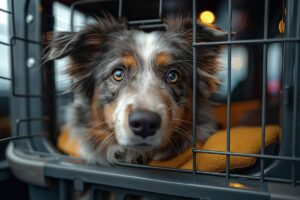We all adore our pets and often view them as part of the family. Whether it’s a loyal dog or a cuddly cat, the thought of leaving them behind can feel heartbreaking. Yet, when it comes to vacations or long trips, pet owners are faced with an important decision: Should we bring our pets with us or make arrangements for someone to care for them while we’re away? While quick errands and short absences are usually fine, extended travel is a different story. This is when hiring an experienced overnight pet sitter can make all the difference, offering a safe, comfortable, and loving alternative for pets who would rather stay home than travel the world.
When considering a trip, many pet owners are overwhelmed by the logistics of either bringing their pet along or making proper arrangements at home. Let’s explore both scenarios—taking your pet with you or leaving them behind—and determine what’s best for you and, most importantly, your furry friend.
Should They Stay or Should They Go?
Choosing between traveling with your pet or hiring an overnight pet sitter at home begins with evaluating your trip details. Are you heading into the mountains for a weekend road trip, or are you flying overseas for a two-week vacation? Each situation calls for different preparations, and your pet’s needs must be the top priority.
Option 1: Leave Them at Home
 If you choose to leave your pet at home, you have to ask: Who will care for them in your absence? Your options range from asking a neighbor to pop in and feed them once a day to booking full professional overnight pet sitting services.
If you choose to leave your pet at home, you have to ask: Who will care for them in your absence? Your options range from asking a neighbor to pop in and feed them once a day to booking full professional overnight pet sitting services.
Asking a friend or neighbor might seem convenient, but pets often do best with consistency and supervision. What happens if your neighbor forgets to stop by or if your pet falls ill during your absence? That’s where overnight pet sitters shine. A trustworthy overnight sitter provides continuous care by staying in your home, following your pet’s usual schedule, feeding them, walking them, administering medication if necessary, and most importantly—keeping them company.
Many pets, especially dogs and cats, experience separation anxiety or behavioral issues when left alone for too long. Overnight pet sitting helps mitigate this by offering companionship in a familiar environment, which reduces stress and supports overall emotional well-being.
Option 2: Bring Them Along
If you decide to bring your pet with you, the most important factor to consider is how you plan to travel.
Travel by Car
Pets who enjoy riding in the car and don’t get motion sickness may enjoy a road trip. Make sure to use a crate or harness for vehicle safety and plan regular breaks for walks, water, and bathroom breaks.
Travel by Plane
Flying with your pet is a much more complex process and often requires months of preparation—especially for international trips.
Here are the key considerations if air travel is your choice:
Book Early and Research Extensively
Give yourself at least three months to prepare. Not all flights or airlines accommodate pets on board or in cargo, and breed restrictions might apply.
Purchase and Prepare the Travel Crate
Your pet’s crate needs to meet specific airline standards. Don’t just buy one last minute—order it ahead of time and allow your pet to get used to it. Leave the crate open at home, place treats, toys, and blankets inside, and allow your pet to venture in and out freely. For nervous pets, positive crate exposure is especially important to reduce the risk of stress-related health issues during the flight.
Schedule a Vet Visit
Your veterinarian will need to sign off that your pet is fit for travel and up to date on all required vaccinations. Requirements vary depending on:
- Your country of origin (are there local diseases your pet must be vaccinated against?)
- The destination country (do they require health certification, rabies vaccination, proof of deworming?)
- The airline (do they require medical records, certificate of acclimation, or booking confirmation?)
Check and double-check all vet requirements for both air and ground travel, especially for international trips. Keep all paperwork in a secure, easily accessible location.
Prepare for Entry into the Destination Country
Some countries (like Australia, Ireland, or Japan) have strict regulations. Requirements may include quarantine periods, microchipping, specific testing, and health checks. Head to the CDC’s website or the international equivalent for your destination country to get current information.
Consider Your Pet’s Temperament and Age
 Older pets, very young animals, or those with health issues may not be good candidates for air travel or long road trips. Think about whether the trip is justifiable from their perspective. They won’t appreciate the thrill of sightseeing—but they will absolutely notice the stress of unfamiliar scenery, loud noises, and interrupted routines.
Older pets, very young animals, or those with health issues may not be good candidates for air travel or long road trips. Think about whether the trip is justifiable from their perspective. They won’t appreciate the thrill of sightseeing—but they will absolutely notice the stress of unfamiliar scenery, loud noises, and interrupted routines.
Hiring an Overnight Pet Sitter
If all of this seems overwhelming, it’s because it is. Traveling with pets, especially by plane, requires elaborate preparation and a lot of moving pieces—all of which can impact your peace of mind. That’s why hiring a professional overnight pet sitter is often the best choice for pet parents.
An overnight sitter offers several invaluable benefits:
- Your pet stays in a familiar environment with their bed, toys, smells, and routines.
- There’s less stress compared to boarding facilities or travel-related chaos.
- Pets receive personalized attention and care tailored to their unique needs.
- Sitters monitor your pet’s well-being and are trained to handle emergencies.
- You return to a well-maintained home and a relaxed, happy pet.
Best of all, you get peace of mind knowing that someone experienced and compassionate is caring for the pet you love.
Book Northern Virginia’s Top Overnight Pet Sitters
Deciding whether to bring your pet along or leave them at home is never easy. Travel requires careful planning and prioritizing your pet’s comfort, safety, and health. While some furry companions are travel-friendly adventurers, others are happiest right at home with a familiar daily routine and the undivided attention of an overnight pet sitter.
Before making any decisions, consider your pet’s age, temperament, breed, and health status. Think about the logistics of your trip and your comfort level with managing the necessary preparations. And whatever you decide, taking the time to plan ensures your pet stays safe and happy—whether on the road or curled up in their favorite spot at home.
If you’re gearing up for a vacation or extended travel, don’t let pet care become a stressful hurdle. Let Paw Pals Pet Sitting provide your beloved furry friend with the dedicated care they deserve while you’re away. Our trusted overnight pet sitters offer in-home visits, companionship, feeding, medication administration, and everything else your pet needs to stay happy and comfortable in your absence.
Contact Paw Pals Pet Sitting today to book an overnight pet sitter and enjoy your next getaway knowing your pet is in capable and loving hands. Peace of mind—for you, and your pet—is just a call away.


